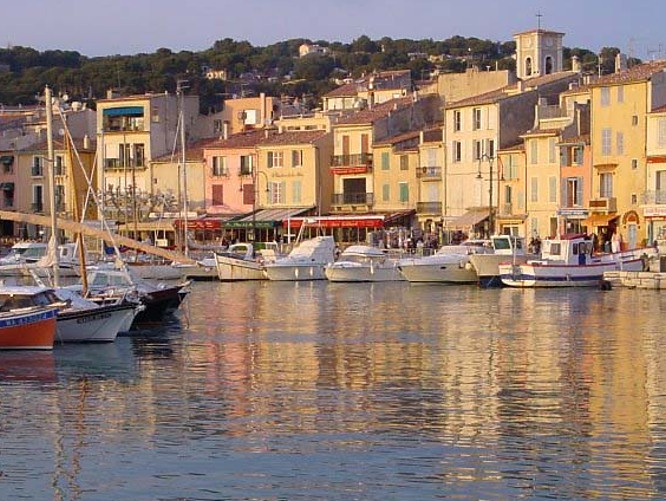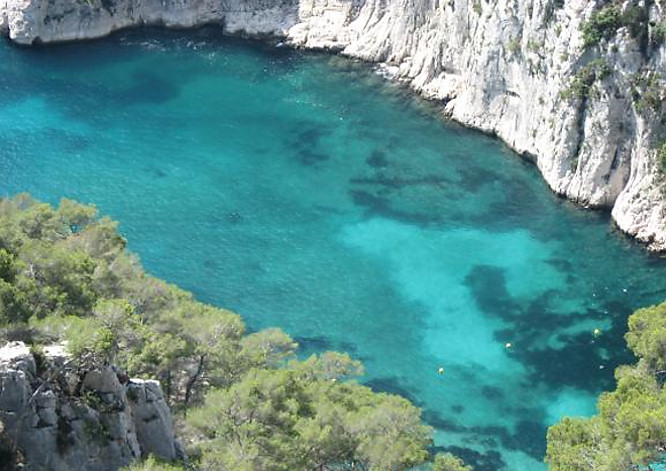Marseille day trip to Cassis
A great day trip from Marseille is to the nearby Mediterranean fishing village of Cassis. Trains from Marseille St Charles to Casis take 20-25 minutes and even on a Sunday you should not have a problem as service is reasonably frequent.

Trains from Marseille St Charles Station to Cassis take 20-25 minutes and even on a Sunday you should not have a problem as service is reasonably frequent. From Cassis train station there is a frequent shuttle bus into Cassis centre. However, the shuttles don't run on Sundays so you will have to take a cab. It is a 30 minute walk to the centre of Cassis if you are feeling energetic.
The town of Cassis, dates back to the ancient Greeks and Romans. The village was rebuilt on the old ruins in the 18th century, resulting in a more regular layout than most other medieval villages. There is an open-air artists market.
The harbour area is the prettiest part of Cassis. Little fishing boats now share the harbour with yachts and a collection of tourist day boats. There are lots of charming dockside cafes and restaurants where you can while away a few hours watching the world go by as you enjoy a cold beer. Each building is a different shape and size. Most have also been painted in contrasting pleasing pastel colours.
There are few designer shops in the narrow streets. Instead you're likely to see fishermen hauling their fresh catches of the day- spiny crabs, baby squid, clams, prawns, sea urchins-straight from the dock into the restaurants..

The beach can become a bit cramped, but the water and cliffs are beautiful. Cassis has a fine sandy beach just outside the port, the Plage de la Grande me. The beaches Plage du Corton and Plage de l'Arene are on the coast just to the south of the village. Just west of the port are the beaches La Plage du Bestouan and La Plage Bleue; in between are is the huge sloping stone shelf popular as a nudist beach.
The wines of Cassis are white and rose, and not to be confused with creme de cassis, a specialty of Burgundy which takes its name from blackcurrants (cassis), not the commune. There is a tourist train that travels around the village. It takes you on a 40 min guided tour to discover the history of Cassis, the fishing and stone industry etc. The train will also stop at the Calanque of Port-Miou near Notre Dame de Bon Voyage chapel.
Cassis The Four Nations Fountain
This recently constructed fountain is the heiress of an older one built in 1690. This monument reproduced a Parisian fountain that was built in 1686 to celebrate the victories of Louis XIV. It was so finely executed that when seen by Parisian travellers they noted in their correspondence 'those who have seen the Fountain of Paris, haven't seen anything until they've seen the Fountain of Cassis'.
This expression, transformed by Frederic Mistral at the beginning of the 20th century, endures and has become emblematic of the village. According to local history, the original fountain was accidentally broken in 1785 by a Catalan fisherman who had climbed to the top of it so that he could have a better view of the Midsummer's Day festivities of Saint-Jean.
Cassis the fountain Baragnon
In the middle of the park, this fountain pays homage to Pierre Baragnon, owner of the castle of Fontcreuse in the 19th century and Adviser General of the Canton for 20 years whose untiring efforts gave way to the water channel between Marseilles and Cassis in 1892
Cassis L'hotel de ville (Town Hall)
This private mansion was built during the 17th century by Desire of Moustiers, former consul of Marseilles. It then passed through the hands of several owners before being bought in 1938 by the municipality of Cassis to serve as the Town Hall which has resided there since 1945. It has been a listed building since 1984 thanks to the rich heritage that it holds within: the Salon d'Honneur with its coffered ceiling, the Renaissance chimney, the chapel with it's ornate ceiling, the facade with its Louis XIII windows and the fine entrance hall with balustrade staircase. Restoration work carried out in 1998 allowed the update of its medieval vestiges which are visible from the ground floor thanks to windows in the flagstones.
Cassis villa l'ariane
This country house of italo-provencal style formerly belonged to a wine grower from Cassis. Respectfully restored by the Municipality, it now accommodates, on three floors, the Public library and the School of Music which is housed in an ancient greenhouse that overhangs a decorative garden.
Cassis villa mauresque
Joined to the castle, this dwelling from the turn of the 20th century owes its name to its style, which recalls the colonial properties that were built in Algeria at about the same time. It was bought, along with the castle of which it was formerly dependant, by an American who had fallen in love with Cassis. On his death, his estate was passed hand to hand, until the Municipality repurchased the Villa in 1979. Currently closed to the public, it is undergoing a restoration project to develop a cultural space.
Cassis tribunal de peche (Fishing Court)
Located alongside the port on the Barthelemy quay, it testifies to the long time prevalent activity of the commune, that's to say the fight by the people of Cassis to distance themselves from the 'despotic, tyrannical, expensive, suspect and abusive' jurisdiction of the conciliation boards of Marseilles. This right was granted to them in 1791. The facade of the courthouse houses, in a niche, a wooden statue of Saint Pierre, (Saint Peter) patron saint of fishermen, which was restored in 1984 and is traditionally carried out in procession to the church on the last Sunday in June ; the time of Saint Pierre. The ceremony is followed by a blessing made at sea to all boats and a homage is made to all missing sailors.
Cassis bestouan iron factory
Located at the bottom of the bay of Bestouan, it constitutes a fine example of industrial heritage from the Second French Empire. It was the location of a very short lived iron and steel industry considering its construction began in 1856 and its liquidation was marked in 1861.Fate dealt a bad hand when, just after its construction, there was a serious economic crisis which was to be fatal for the business. The site now boasts two inhabited dwellings, a wall at the foot of the cliff, an arched door framed by two semicircular windows, stone corbels and a 33m high chimney.
Cassis Castle
A fortified building from between the 8th-9th centuries, undoubtedly built on the vestiges of a first building from the 8th century. The fortress has belonged to the powerful Baux family since 1232, who also own the Baronship of Aubagne and the Lordship of Roquefort. It is inside this "fortress" that medieval Cassis developed and where the people sought protection from barbarian invasions and bandits. At the end of the 15th century this castle sheltered more than 250 inhabitants.
Taken by storm in 1524 by the troops of Charles Quint, the Citadel was then gradually left behind in preference for the small township that had developed on the edge of the shore and the castle then became a military fortress. Sold by the Domaines in 1896 and resold on several occasions, the castle is now private property and has been developed into a luxury hotel.
Cassis Camargo Foundation
At the beginning of the 1930's, having studied painting in Paris, Jerome Hill, an American artist and heir to the designer of the Great Northern Railroad, paid several visits to Cassis. He succumbed completely to the magic of the area, and in 1939 he bought a house and it's surrounding grounds from Madge Oliver, an English painter and professor of Art of whom Winston Churchill was one of her more famous pupils.
In 1960, Hill extended his property with the purchase of the adjacent Panorama hotel. In 1967, he created the Camargo Foundation which receives up to 12 'fellows' each year; painters, plastics technicians, writers, photographers and film makers who, accompanied by their family, wish to work on French culture. Today, the buildings of the Camargo Foundation house, not only apartments intended for the artists, but also a library, a music room, a conference room and a photography darkroom.
Cassis The Windmill of Marc
This edifice, which is currently under development, is the last remaining example in Cassis of the windmills that were formerly used to grind wheat. The date that is engraved on the stone lintel above the main door probably corresponds to the year of construction.
Cassis The Furnace House
Work carried out in 1999 on a building located at the corner of the la rue du Four (Furnace Street) and la rue Therese Rastit revealed the existence of a well conserved baker's oven that probably dates back to the beginning of the 18th century. It appears to be a communal oven as there were several in Cassis during the 16th century and it was situated nearby a communal oil press. This bakery also revealed in its cellar the remains of pottery dating back to the 1st century BC, which confirm the existence of a port or mooring place in Cassis during this time.
Calanques of Marseille, the Fiords of Southern France
The limestone cliffs of southern France a highly eroded and have numerous inlets and amazing white sand beaches and turquoise sea. Boats can be taken from the port of Cassis along the Rocky coast. You can ask the captain to drop you on one of the many bays and pick you up again a few hours later or you can walk. There are magnificent places for swimming, walking, climbing or just relaxing.
Travel books

